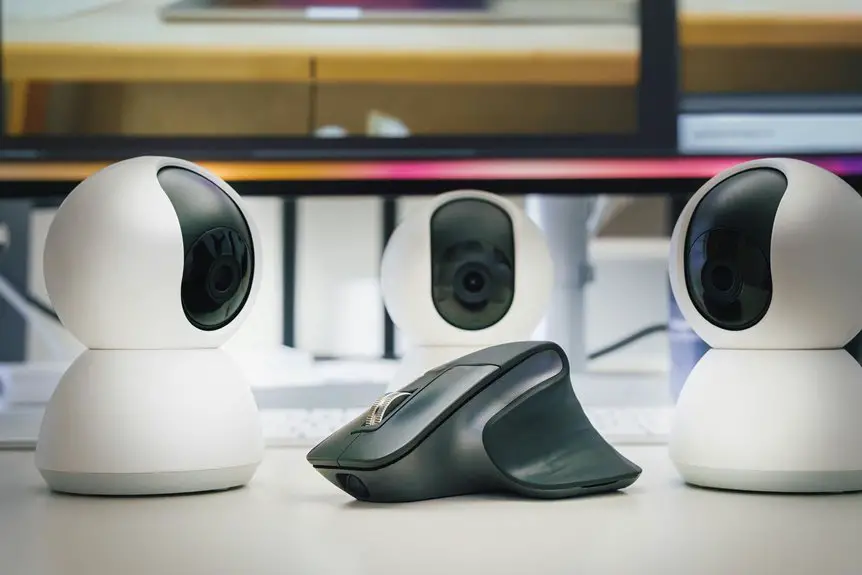When choosing the right webcam field of view (FOV), think about your setting and purpose. A wider FOV works great for group calls, capturing more of the surroundings, while a narrower FOV keeps the focus on you, minimizing distractions. Position your webcam at eye level, tilt it slightly down for flattering angles, and ensure your background isn't cluttered. These adjustments can significantly enhance your virtual presence. Discover more tips to optimize your video calls effectively.
Table of Contents
Key Takeaways
- Determine your FOV based on the call type: narrow for individual focus, wide for group interactions.
- Position your webcam at eye level for optimal engagement and viewer connection.
- Test different angles, tilting slightly downward for a flattering perspective.
- Ensure adequate headroom and center your face within the frame for a professional appearance.
- Consider the background; it should be tidy and non-distracting to maintain viewer focus.
Understanding Field of View (FOV)
Field of view (FOV) is a crucial concept when it comes to webcams and how you perceive your surroundings during video calls. FOV refers to the extent of the observable area that your camera captures.
A wider FOV lets you include more of your environment, which can be great for group calls or showing your workspace. On the other hand, a narrower FOV focuses more on you, minimizing distractions.
When choosing a webcam, you'll want to consider your purpose. If you're often in a cozy setting, a wider FOV can enhance engagement.
However, if you're presenting or discussing specifics, a tighter FOV may be preferable. Understanding FOV helps you select the right webcam to optimize your video calls.
The Importance of FOV in Video Quality
When selecting a webcam, understanding FOV is vital because it directly impacts video quality. A wider FOV can capture more of your surroundings, making it ideal for group calls or presentations.
However, too wide of an angle may distort the image, leading to a less professional appearance. Conversely, a narrower FOV focuses tightly on you, providing clear, detailed video but limiting the background.
This can create a more intimate setting for one-on-one conversations. Your choice of FOV can affect how viewers perceive you and your environment, ultimately influencing engagement and communication.
Therefore, consider your specific needs and settings when deciding on the right FOV for optimal video quality and viewer experience.
Different Types of Webcam FOVs
Choosing the right type of webcam FOV can significantly enhance your video experience, as each option serves different purposes. Generally, webcams offer three primary types of FOV: narrow, medium, and wide.
| FOV Type | Description |
|---|---|
| Narrow | Focuses on only the subject, ideal for one-on-one calls. |
| Medium | Captures a balanced view, suitable for small group interactions. |
| Wide | Expands the view, perfect for larger groups or presentations. |
| Adjustable | Allows you to customize the FOV, providing flexibility for various situations. |
Understanding these types helps you select the most suitable option for your needs, enhancing your overall video quality and engagement.
Choosing the Right FOV for Your Needs
When choosing the right FOV for your webcam, think about how you'll use it and the size of your room.
A wider FOV works great for large spaces or group settings, while a narrower one can focus on individual details.
Consider your needs to make the best choice for your setup.
Purpose of Webcam Use
As you consider how to use your webcam, understanding the right field of view (FOV) is essential for capturing the perfect shot.
Your purpose drives the choice of FOV—whether you're connecting with friends, conducting a business meeting, or streaming gameplay. For one-on-one chats, a narrow FOV may suffice, focusing on you and your expressions.
However, if you're hosting a group call or teaching a class, a wider FOV captures more participants and the environment. For streaming, a broader view can showcase your setup and engage viewers better.
Tailoring the FOV to your specific needs ensures you present yourself effectively, enhancing your communication and connection with the audience.
Prioritize clarity and engagement in every shot.
Room Size Considerations
The size of your room plays a crucial role in determining the right field of view for your webcam. A small room may not need a wide FOV; you want to focus on your face without capturing too much background. Conversely, larger spaces can benefit from a broader FOV to include more of the environment. Here's a quick reference to help you choose:
| Room Size | Recommended FOV | Purpose |
|---|---|---|
| Small | 60° – 75° | Close-up meetings |
| Medium | 75° – 90° | Casual chats |
| Large | 90° – 120° | Group presentations |
| Very Large | 120°+ | Events and workshops |
| Variable | Adjust as needed | Custom setups |
Tips for Adjusting Your Webcam Angle
Adjusting your webcam angle can significantly enhance your video quality and overall presentation.
Start by positioning your webcam at eye level to create a more engaging perspective. If you're using a laptop, consider stacking it on a few books or using a laptop stand.
Experiment with tilting your camera slightly downward; this can help avoid unflattering angles. Make sure your face is centered in the frame and that there's enough headroom above you.
Check the background—ensure it's tidy and not distracting. Good lighting is crucial, so aim for natural light or use a soft lamp to illuminate your face evenly.
Finally, do a test recording to see how everything looks before your important call or meeting.
Enhancing Your Virtual Presence With FOV
To enhance your virtual presence, choosing the right angle for your webcam is crucial.
Proper lighting and a clean background can also make a big difference in how you're perceived.
Let's explore how these elements come together to create a more professional appearance.
Optimal Angle Selection
Choosing the right angle for your webcam can significantly enhance your virtual presence, making you appear more engaged and professional.
Start by positioning your camera at eye level; this creates a natural, direct connection with your audience. Tilt the webcam slightly downward to avoid an unflattering view from below. A slight angle can also help to showcase your environment without being overly distracting.
Experiment with the distance between your face and the camera. Too close can be overwhelming, while too far may make you seem disconnected. Aim for a head-and-shoulders shot, which invites interaction.
Lastly, keep your posture straight and lean in slightly to convey interest. With these adjustments, you'll project confidence and engagement in your virtual meetings.
Lighting and Background Considerations
While you might've the perfect angle for your webcam, the right lighting and background are equally crucial for creating an engaging virtual presence. Good lighting enhances your features and ensures you're clearly visible. Natural light works wonders, but if that's not an option, invest in soft, diffused lighting to avoid harsh shadows.
Position your light source in front of you, not behind.
As for the background, keep it clean and uncluttered to avoid distractions. A simple, neutral backdrop works best, but you can add personal touches, like artwork or plants, to reflect your personality.
Just make sure it doesn't overwhelm the viewer. By focusing on lighting and background, you'll elevate your virtual presence significantly.
Frequently Asked Questions
How Does Lighting Affect My Webcam's Field of View?
Lighting significantly impacts your webcam's performance. Good lighting enhances clarity and reduces shadows, making your image appear sharper. Poor lighting can distort colors and details, making it harder for viewers to see you clearly.
Can I Change My Webcam's FOV Settings in Software?
Yes, you can change your webcam's field of view settings in software, depending on the application. Adjust the settings in your webcam software or video conferencing platform to customize the view according to your preferences.
What Is the Ideal Webcam FOV for Streaming?
The ideal webcam FOV for streaming depends on your setup. Generally, a 90-120 degree angle works best, capturing your face while including enough background to create an engaging atmosphere without overwhelming viewers.
Does FOV Impact Bandwidth Usage During Video Calls?
Yes, FOV affects bandwidth usage during video calls. A wider angle captures more detail, increasing data transmission. Conversely, a narrower FOV typically uses less bandwidth, allowing smoother performance, especially on slower connections.
Are There Any Accessories to Improve FOV on Webcams?
Absolutely! You can use wide-angle lenses, external camera mounts, or even adjustable stands to enhance your webcam's field of view. These accessories can help you capture more of your surroundings during video calls.




